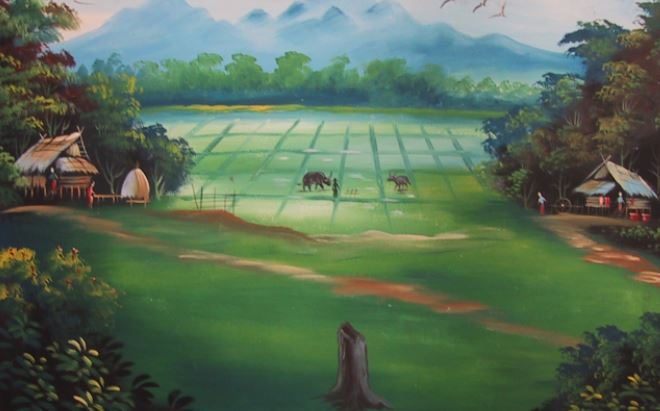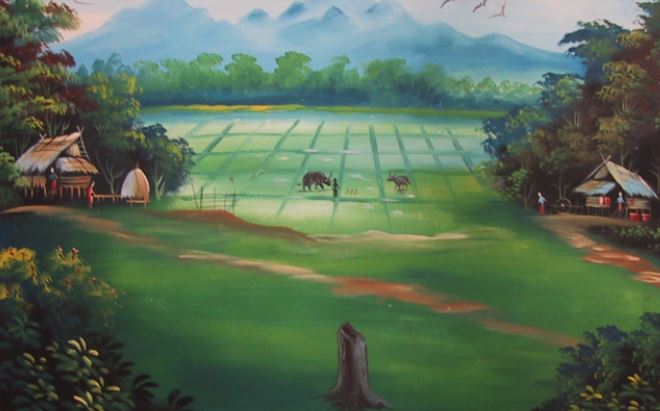I’ve been a regular visitor to the New Mandala website for many years now. Indeed, it’s virtually (pun intended) the only connection I still have with my old alma mater and the academic world more generally. Back in 1979 I had the very good fortune to go to the ANU when tertiary education was free and the government provided students with a stipend that was, with a bit of luck, enough to get by on without recourse to some meaningless job. Totally inconceivable in the world in which we now live.
I was also extremely lucky to have studied Thai with the peerless Ajarn Tony Diller (Dr A.V.N. Diller), very ably assisted by Vaccharin (Khun Lek) McFadden. That experience is what I now regard as the high point of my life in the Canberra academy where, apart from completing three degrees: a BA, a Masters, and a PhD, I also taught a few short Thai language courses, as well as being employed, post-doc, in a minor administrative role in the Southeast and East Asia graduate program.
I’m forever grateful to Ajarn Tony for his inspirational teaching and encouragement as an undergraduate. Indeed, I would have never done Honours, nor an MA, nor a PhD without that early background or training or whatever you’d like to call it at ANU from 1979-82. I’m still learning Thai, and everything else that entails, to this very day (and English of course) and will continue to do so until the day I die.
Nowadays I still read Thai newspapers, fairly regularly, listen to the radio occasionally, while avoiding Thai TV altogether – as the old truism goes: life is far too short. Anyway a few weeks back I happened to be reading a copy of Matichon – which says, above the ‘masthead’ – ‘A quality newspaper, for the quality of the country’. A sentiment I can generally endorse although, like everything else, it certainly has its ‘off moments’. Having said that Ajarn Nithi/Nidi’s columns are nearly always worth reading and so are many by Sujit Wongthet (Sinlapa-wattanatham [Art and Culture] under his stewardship often had much to recommend it back in the day).
So I came across a column dealing, in a manner of speaking, with ‘Thainess’, a subject I was once rather interested in. Less so now, but old habits die hard. So I thought I’d translate it and post the result on New Mandala. I don’t really want to add any comments or opinions of my own. I think we can probably all agree on one thing – Thai politics is nothing less than cans of worms inside of cans of worms ad infinitum on down the line. Perhaps best left to the likes of thoughtful political scientists, non-partisan commentators and the Andrew MacGregor Marshalls of this world (AMM your work is ferocious – that’s a compliment by the way; metaphorical ‘bombs’ are very much needed in this peculiar country, notwithstanding the appalling collateral damage they can inflict).
The article in question is written by Chettawan Tueaprakhon a person whose name is unfamiliar to me. Perhaps there are some readers out there who could fill us in. He may be a red-shirter for all I know, or he may be a reasonably neutral figure. Clearly he is no fan of the reheated paternalism on offer from the PRDC et al.
By the way the piece was accompanied by Chettawan’s email address so I wrote to him (unfortunately in English, as the Thai keyboard skills I developed over a decade ago have fallen into disuse and atrophied). I told him I liked the article and was curious to know which magazine he was referring to, it sounds suitably perverse. As yet I have not received a reply.
Scot Barmé – author of Woman, Man, Bangkok: Love, Sex and Popular Culture in Thailand Boulder, Colorado: Rowman and Littlefield, 2002 (republished by Silkworm Books, Chiang Mai 2006); Kulap in Oz: A Thai view of Australian life in the 1940s, Melbourne: Asia Institute Monash University, 1995; Luang Wichit Wathakan and the creation of a Thai identity, Singapore: Institute of Southeast Asian Studies, 1993 – lives in Thailand.
#######
‘Can we really live together like this?’*
Chettawan Tuenprakhon, Matichon, 15 March 2014, p.14
Recently while reading a particular (unspecified) monthly magazine in which the theme of ‘Thainess’ (khwam pen thai) was fore-grounded I almost gagged. I never thought or imagined in the twenty-first century our society would see a campaign exhorting people to be proud of something that is but an abstraction in the extreme. To create a ‘nationalist’ consciousness of a type that would mystify or bewilder any non-Thai (khon tang chart) able to read the vernacular.
The world moves forward, relentlessly. Yet it’s as if the conservative side in this country is attempting to obstruct or block the flow. The more the currents of globalisation find their way into every nook and cranny, the more this group of people find the changing nature of things intolerable. It’s reached the stage where histrionic, braying calls are being made for ‘Thainess to be put in aspic, or fixed in time’, as in the past. Such a state of affairs begs the question ‘can we really live together like this?’
When speaking of the magazine referred to above, I should point out it was an issue commemorating the month of love (specifically the celebration of Valentine’s Day, a day which, incidentally, is part and parcel of this global current; it’s not Thai, that’s for sure). The cover of the magazine featured a high-profile married couple in the entertainment industry dressed to the nines with a Thai flag spread out on the floor behind them. It appears that this issue about love was (simultaneously) about loving Thailand.
It’s well known where these two big stars stand. After all didn’t they go out and blow their whistles and join in with the Shut Down Bangkok (PDRC) crowd? A movement demanding the establishment of a‘People’s Council or Assembly’ though one not elected by the public/people (prachachon).
One may say that these two individuals do ‘love the nation’ (rak chart). But do they love the nation any more than those who want to see elections held? Do they love the nation more than Nong Mei – Ratchanok Inthanon, someone who brought glory to this country as a badminton player but who is now vilified and intimidated for not loving the nation. And the reason why? Simply because she exercised her right to vote in the elections on 2 February.
Reading the interview you get a sense of the power of conservatism, its desire to ‘fix or freeze’ this country in time. The couple came out to show their love of the nation citing the reason they joined in with the PDRC was that the government had done things that were not correct, things it shouldn’t have done (mai thuk mai khuan). You can well imagine had the interviewer been more forthright and asked – ‘Can you elaborate on that, what sort of things for example?’ the answer would have simply been accusations of ‘corruption’ or allegations of plotting to bring down the monarchy (lom jao) – basically the type of response that is devoid of anything substantive. If the interviewer was really doing a good job he or she may have asked them to provide a little evidence to support such views – for example what was the precise nature of the corruption, or explain how the monarchy was to be overthrown?
And, somewhat ironically, while stating that the government was engaged in wrongful and inappropriate activity these two stars were only too happy to endorse PDRC demands: for the military to seize power, a new prime minister to be appointed by royal decree, the establishment of a People’s Assembly, and the abandonment of holding elections per se. None of these things is sanctioned by law or specified in the constitution. Moreover, the very notion of wrongful, and inappropriate doesn’t even include the actual obstruction of polling that took place during the elections by individuals associated with the PDRC. Nor does it extend to claims made by this group that it was engaged in peaceful, unarmed, civil disobedience– an assertion lacking any credibility whatsoever.
In addition to the interview the magazine also featured a more general piece of reportage and a fashion spread emphasising ‘Thainess’. The whole kit and caboodle was framed with the aim of urging readers to ‘love the nation’.
I encourage you to take a look at the various celebrity couples used in the fashion shoot. This section actually kicks off with words we hear over and over again prior to the playing of the national anthem at eight o’clock in the morning and again at six in the evening: ‘The Thai national flag and national anthem are symbols of Thainess. Therefore we stand at attention and pay our respect to the flag and the sovereign independence wrought by of our forebears.’
Then there is a nod to the sponsors – suppliers of clothing, apparel and accessories (all brand name items made available by global currents). There are a total of nine couples shown standing rigidly upright as if in a reverential attitude of ‘paying respect’ in various locales the conservative side defines as ‘Thai’.
The first couple appears before the Phra Thi-nang Ananta-Samakhom Throne Hall; the second couple in the midst of a lush green paddy field; the third at Hua Lamphong Railway Station – with an old locomotive in the background; the fourth at a market in Yaowarat in Chinatown; the fifth among a group of classical Thai dances at the Thao Mahaphrom Shine near the Erawan Hotel at the Ratprasong intersection; the sixth couple are photographed with puppets at the artist’s village at Khlong Bang Luang, Thonburi; the seventh pair are shown in front of a traditional Thai-style house (with some buffaloes nearby); the eight couple are shown at a Thai boxing ring together with three foreigners [westerners] in boxing attire standing rigidly erect in a respectful pose, while the ninth couple are standing in front of a tuk-tuk.
So that’s ‘Thainess’ is it? Is it that standing at attention in front of these things indicates ‘pride’ and ‘love of the nation’? But what about other forms of art and culture, and other ethnicities (chart-phan) who were involved in the creation of the nation, where exactly are they?
We mustn’t forget that the Thai nation (chart thai) wasn’t only created by one group of people – there were others including: Thai/Tai, Vietnamese, Lao, Lue, Malays, Mon, Chams, Kui [name of ethnic group?] and westerners/Caucasians. Indeed, they were various others involved in this creative process. It – ‘Thainess’ – simply can’t be classified in terms of nine things, nine categories. Where did this come from, how did it come about?
So, again, we need to ask ‘Can we really live together like this?’ Are we going to ‘fix, or freeze’, in time the things I’ve mentioned above? Are we going to have the people in this land (phaen din) live in traditional Thai style houses that are very expensive to maintain? Should farmers live lifestyles of yore, using buffaloes to till the rice fields, do their shopping in dusty, smoky, noisy markets and travel in slow trains and tuk-tuks? People don’t have to think, just pray and make offerings to the lords (jao) and deities (thep). No need to depend on one’s own abilities or one’s labour.
So, I repeat my question – ‘Can we live together like this?’
* Translator’s note: All comments included in parentheses – that is those with the exception of romanized Thai words in italics – are those of the author of this piece. Similarly, words that appear in ‘inverted commas’ also appear in the original Thai text.
 Facebook
Facebook  Twitter
Twitter  Soundcloud
Soundcloud  Youtube
Youtube  Rss
Rss 
